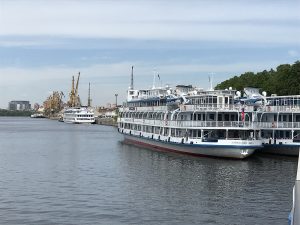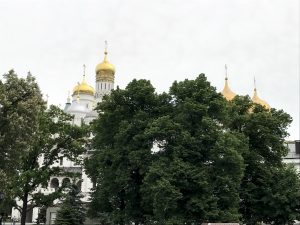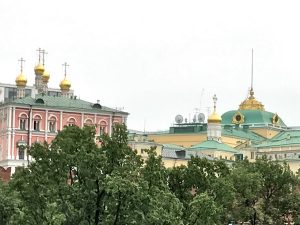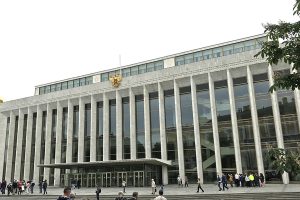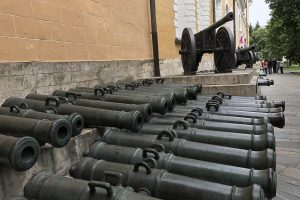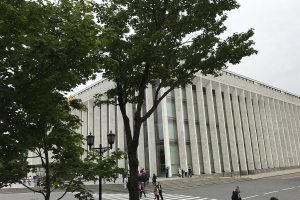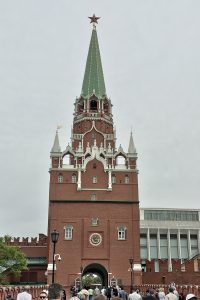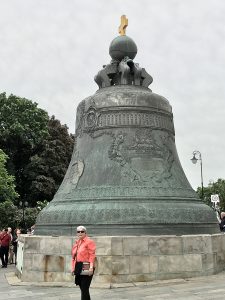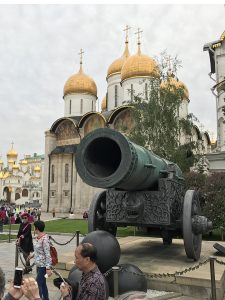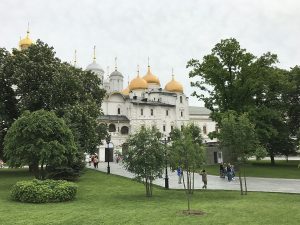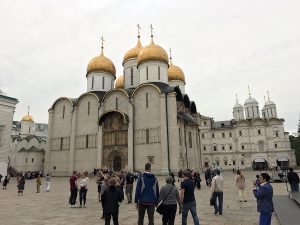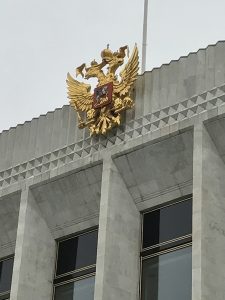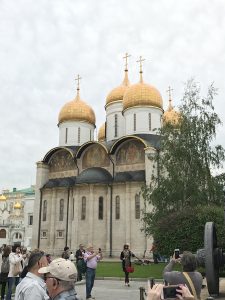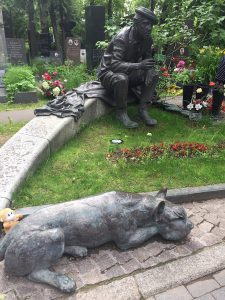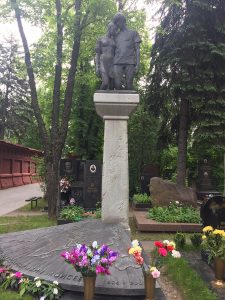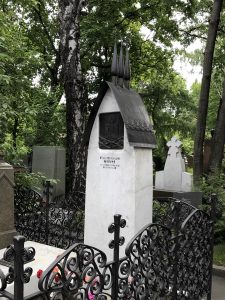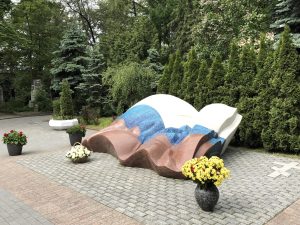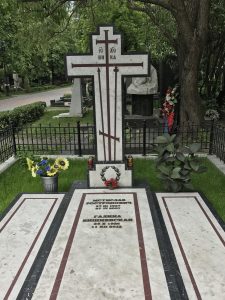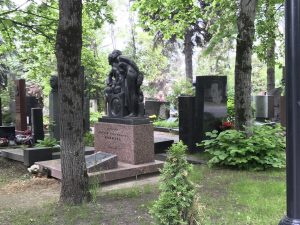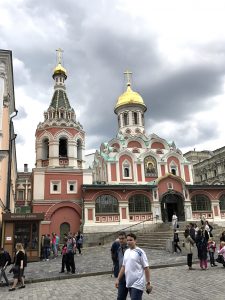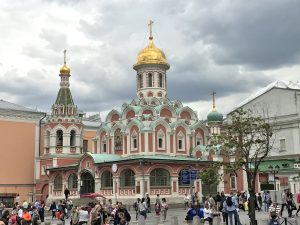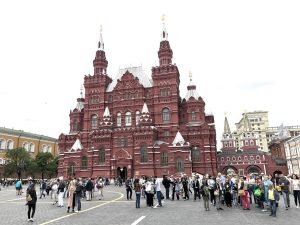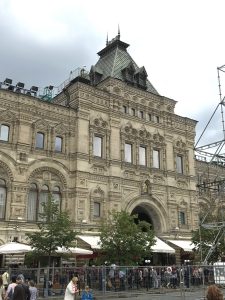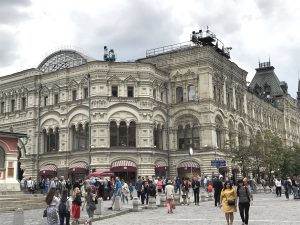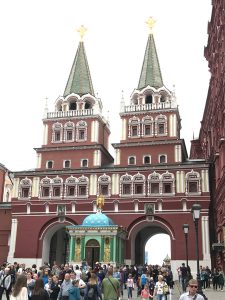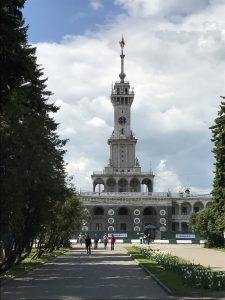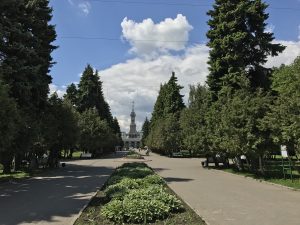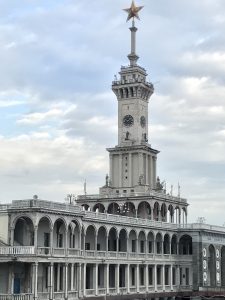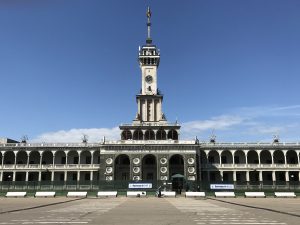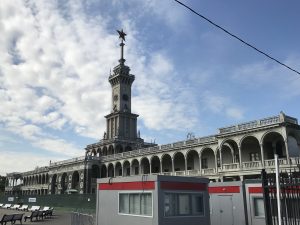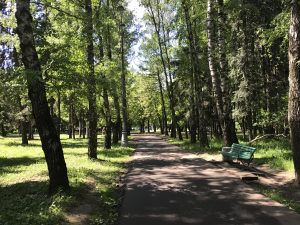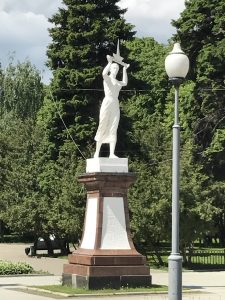Imperial Waterways of Russia
June 9-11
Moscow
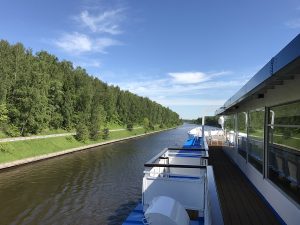 Of all the prejudices I had about Russia—about the the Soviet Union, to be accurate—none were more ingrained than my expectations about what we would see in Moscow. For background, please understand that Judy and I had driven from Bamberg, in the former West Germany, to Leipzig, in the former East Germany, in 1993. We had seen a huge difference between the two former countries only three or four years after the unification. Just crossing the former border pointed out the contrast on every side. We had also visited both Leipzig and [East] Berlin in 2003, and we really noticed the difference in the former East German cities by that time. Color and excitement were visible everywhere in full, and it appeared that the former drab architecture was gone from that area. Perhaps we should have remembered that difference; it’s possible we would have been more prepared for what we saw in Moscow.
Of all the prejudices I had about Russia—about the the Soviet Union, to be accurate—none were more ingrained than my expectations about what we would see in Moscow. For background, please understand that Judy and I had driven from Bamberg, in the former West Germany, to Leipzig, in the former East Germany, in 1993. We had seen a huge difference between the two former countries only three or four years after the unification. Just crossing the former border pointed out the contrast on every side. We had also visited both Leipzig and [East] Berlin in 2003, and we really noticed the difference in the former East German cities by that time. Color and excitement were visible everywhere in full, and it appeared that the former drab architecture was gone from that area. Perhaps we should have remembered that difference; it’s possible we would have been more prepared for what we saw in Moscow.
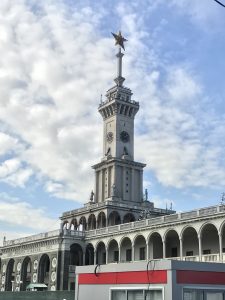 We spent the morning of Friday completing our journey through the Moscow-Volga Canal. Mid-day we docked at the Northern River Terminal and I think everyone on board was excited. Before I go on with my usual blow-by-blow description of our afternoon, let me say that I was immediately struck by the building at the docking site. Wow. A deserted building, hundreds of feet long and striking in its appearance, it was built to celebrate the opening of the Moscow-Volga Canal in 1937 as a symbol of Soviet progress after the Revolution.
We spent the morning of Friday completing our journey through the Moscow-Volga Canal. Mid-day we docked at the Northern River Terminal and I think everyone on board was excited. Before I go on with my usual blow-by-blow description of our afternoon, let me say that I was immediately struck by the building at the docking site. Wow. A deserted building, hundreds of feet long and striking in its appearance, it was built to celebrate the opening of the Moscow-Volga Canal in 1937 as a symbol of Soviet progress after the Revolution.
The canal is important, not least because it allows tourists like us to make the trip, but somehow it was the building itself that caught my attention. In fact, you’ll find that a small portion of the photographs I made of the building occupy a separate tab in the photos at the bottom of the page. Judy was as fascinated as I was by the number of people who seemed to just spend time in the small park next to the building. There were families, couples, and singles young and old who just sat around, skate boarded, or just walked along the canal. To us it was just a point of departure to see the city, but to them it appeared to be a destination in itself. Later I found out that the park we were next to is Friendship Park, opened in 1957 for a Youth Festival. But more about that later.
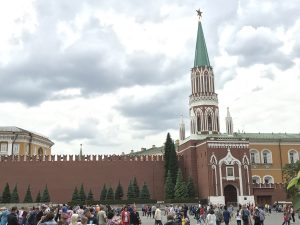 The general excitement felt on board wasn’t about the deserted old terminal building or the park; it was all about going for a guided walking tour of the Kremlin. So we boarded the busses and took off for a ride to the center of the city. There’s not much to say about the scenery, although our guides indicated points of interest the entire way. Unfortunately you really can’t see a lot riding in a bus, and in the end, one big modern city looks a lot like every other big modern city unless you can get out of the bus and look around a bit.
The general excitement felt on board wasn’t about the deserted old terminal building or the park; it was all about going for a guided walking tour of the Kremlin. So we boarded the busses and took off for a ride to the center of the city. There’s not much to say about the scenery, although our guides indicated points of interest the entire way. Unfortunately you really can’t see a lot riding in a bus, and in the end, one big modern city looks a lot like every other big modern city unless you can get out of the bus and look around a bit.
The Kremlin
 By the time we arrived at the Moscow Kremlin, we had all learned a little about kremlins in general. Every town had one, and they were generally walled off from the rest of the town, their purpose being to provide a secure fortification in case of attack. To be sure, most of the passengers on this cruise remembered the Cold War to some extent, so the notion of Moscow’s Kremlin carried for us a lot of baggage. Somehow, in my extreme pre-judgment of what I expected to see, it was the presence of multiple churches in the heart of the Kremlin that surprised me the most. The main square is actually surrounded by four cathedrals and other historic church buildings, and they include enough gilded domes to boggle the senses. Those churches are centuries old, and they’re crowded with icons and other religious art. For us, that was a wonderful surprise.
By the time we arrived at the Moscow Kremlin, we had all learned a little about kremlins in general. Every town had one, and they were generally walled off from the rest of the town, their purpose being to provide a secure fortification in case of attack. To be sure, most of the passengers on this cruise remembered the Cold War to some extent, so the notion of Moscow’s Kremlin carried for us a lot of baggage. Somehow, in my extreme pre-judgment of what I expected to see, it was the presence of multiple churches in the heart of the Kremlin that surprised me the most. The main square is actually surrounded by four cathedrals and other historic church buildings, and they include enough gilded domes to boggle the senses. Those churches are centuries old, and they’re crowded with icons and other religious art. For us, that was a wonderful surprise.
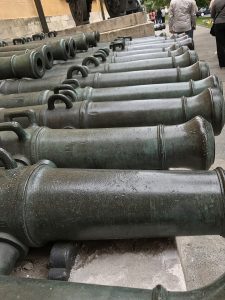 A fun surprise was seeing dozens of cannon barrels stacked up across the street from the 1950s era Congress building. The cannons were left by Napoleon after the winter of 1812, and I have a funny mental image of someone going out after the snow melted and bringing them into the city to stack like so much firewood. The Palace of the Congress, or whatever it is called today, looks like it doesn’t belong there, and there might have been some intent in pointing all those historic cannons at the less than beautiful building.
A fun surprise was seeing dozens of cannon barrels stacked up across the street from the 1950s era Congress building. The cannons were left by Napoleon after the winter of 1812, and I have a funny mental image of someone going out after the snow melted and bringing them into the city to stack like so much firewood. The Palace of the Congress, or whatever it is called today, looks like it doesn’t belong there, and there might have been some intent in pointing all those historic cannons at the less than beautiful building.
We did see a lot of other impressive buildings and objects along our walk through the Kremlin, and you’ll see photos of them at the bottom of this page. I enjoyed the Tsar’s Cannon, a huge thing that has never been fired, the sort of military excess that seems to still exist in those militaristic parades of rockets and missiles through Red Square in broadcasts. A much more peaceful example of excessively large iron casting was the Tsar’s Bell. We couldn’t pass up the chance to take a photo of Judy standing in front of it. It’s a bit large to add to her collection, I’m afraid. And it’s cracked so it wouldn’t be used to call anyone to arms or even to ring out the hour.
 Our walking tour ended with a visit to the Armory, which is now a museum housing historic items of all sorts, from carriages and clothing to documents and jewels. I’m writing this months after our trip, and I’m afraid I was too tired to make many notes after the day. As I recall, we weren’t allowed to make photographs in the Armory Museum, our final stop on this walking tour. I remember seeing all sorts of beautiful examples of everything from carriages to cannons. Really. More cannons. Along with clothing, jewelry, and even historic documents.
Our walking tour ended with a visit to the Armory, which is now a museum housing historic items of all sorts, from carriages and clothing to documents and jewels. I’m writing this months after our trip, and I’m afraid I was too tired to make many notes after the day. As I recall, we weren’t allowed to make photographs in the Armory Museum, our final stop on this walking tour. I remember seeing all sorts of beautiful examples of everything from carriages to cannons. Really. More cannons. Along with clothing, jewelry, and even historic documents.
When we left the Kremlin through another gate, we waddled along to the busses and made our way back to the cruise ship, through something that by comparison to the beauty of the Kremlin was just another city. But we had our memories, even though we didn’t have photos of the contents of the Armory Museum.
Novodevichy Cemetery and Red Square
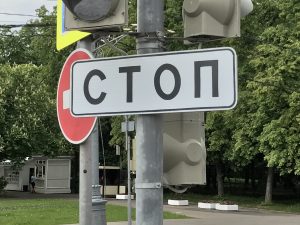 After a restful evening back on the ship, we started the next day with what remains in my memory as one of the dullest and most useless bus rides I’ve ever been on. It felt endless, even though there were several point of interest that could have been seen out the coach windows. I’m sure they were there, because our guide pointed them out and talked about them. But they were almost impossible to see. I don’t mean to sound resentful about it, but I do think a better choice could have been made for our morning activity. On the other hand, I at least snagged a good photo of the ubiquitous “stop” signs during our stop to look over the distant city. The letters don’t look like they would in the Roman alphabet, but this word is good ol’ English and pronounced “stop” in Russian. We saw it everywhere.
After a restful evening back on the ship, we started the next day with what remains in my memory as one of the dullest and most useless bus rides I’ve ever been on. It felt endless, even though there were several point of interest that could have been seen out the coach windows. I’m sure they were there, because our guide pointed them out and talked about them. But they were almost impossible to see. I don’t mean to sound resentful about it, but I do think a better choice could have been made for our morning activity. On the other hand, I at least snagged a good photo of the ubiquitous “stop” signs during our stop to look over the distant city. The letters don’t look like they would in the Roman alphabet, but this word is good ol’ English and pronounced “stop” in Russian. We saw it everywhere.
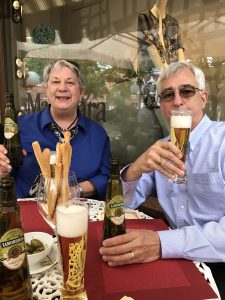 However, the main goal of the day wasn’t just to ride around and fail to see what was being described by the guides. We actually had a worthy reason to leave the ship and head into the city: we were going to have a free day in Red Square. For those of us who had been around more than a few years, there might have been a little trepidation about going there.We needn’t have even thought about the military parades with tanks and missiles. The square was being set up for concerts and all sorts of festivities for Russia Day, and it looked a lot like the same kind of thing at home. Judy and I had a wonderful time, and even ate lunch at Bosco Café, just outside the famous Gum department store. If we hadn’t been so exhausted at this point in the trip, I’m sure we would have made the trek from the Square up the the Metropole Hotel. [If you haven’t read A Gentleman in Moscow, you really should.] Unfortunately, our legs and feet wren’t up to the hike after days of off-ship excursions. That’s an excuse to go back if I ever heard one.
However, the main goal of the day wasn’t just to ride around and fail to see what was being described by the guides. We actually had a worthy reason to leave the ship and head into the city: we were going to have a free day in Red Square. For those of us who had been around more than a few years, there might have been a little trepidation about going there.We needn’t have even thought about the military parades with tanks and missiles. The square was being set up for concerts and all sorts of festivities for Russia Day, and it looked a lot like the same kind of thing at home. Judy and I had a wonderful time, and even ate lunch at Bosco Café, just outside the famous Gum department store. If we hadn’t been so exhausted at this point in the trip, I’m sure we would have made the trek from the Square up the the Metropole Hotel. [If you haven’t read A Gentleman in Moscow, you really should.] Unfortunately, our legs and feet wren’t up to the hike after days of off-ship excursions. That’s an excuse to go back if I ever heard one.
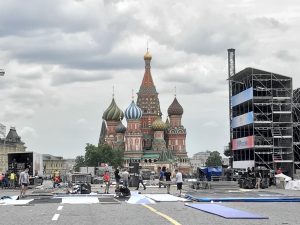 We were there just before the Day of Russia, or Russian Independence Day, even though out guides explained that they didn’t really declare their independence from anyone. They just changed the government system. Some things never change. On the other hand, it was somehow reassuring to see people setting up grandstands, stages, and all sorts of sound equipment for the celebration. That looks the same the world over, I guess. When you have crowds like that, you have to make it possible for the people to see and hear as much as possible. Having that setup in sight of St. Cyril’s, the most easily recognizable building of Red Square, just made it more a more significant and impressive activity, all things considered.
We were there just before the Day of Russia, or Russian Independence Day, even though out guides explained that they didn’t really declare their independence from anyone. They just changed the government system. Some things never change. On the other hand, it was somehow reassuring to see people setting up grandstands, stages, and all sorts of sound equipment for the celebration. That looks the same the world over, I guess. When you have crowds like that, you have to make it possible for the people to see and hear as much as possible. Having that setup in sight of St. Cyril’s, the most easily recognizable building of Red Square, just made it more a more significant and impressive activity, all things considered.
Sitting on the Dock
We made our way back to the meeting place, and from there back to the ship some time in the afternoon, ready for the Captain’s Dinner and preparations for our final day in Russia.
On that last day, Judy and I could have taken the subway back to Red Square, as a lot of our fellow passengers did. We were worn out, though, so we opted to stay in the neighborhood of the Terminal and see a little of daily life in this part of Moscow. And we enjoyed that as much as anything else we did on the trip. First we had a nice walk through the park, out to the subway station. After we crossed the highway (through a pedestrian tunnel–safer that way), There was another smaller park to walk through to get to a neighborhood with apartments and shopping areas.
First we just walked through a mall, then went to an upscale market, but that was a little beyond what we were looking for. Lots of specialty items, and a coffee section that made we drool just a little. It smelled so good just to walk through there! Then we ran into a group from the boat there with one of the cruise directors as a guide. She pointed us to a stairway we had missed in the little mall, and we went down to a supermarket. That’s what we were looking for! Most of the food we saw looked familiar, and their liquor section was huge. We had the most fun, though, finding familiar items from the US with Russian labels. Somehow seeing Friskies on the shelf just tickled my fancy a bit. I didn’t buy a can, but it crossed my mind that our cats might like a taste of “foreign food.”




